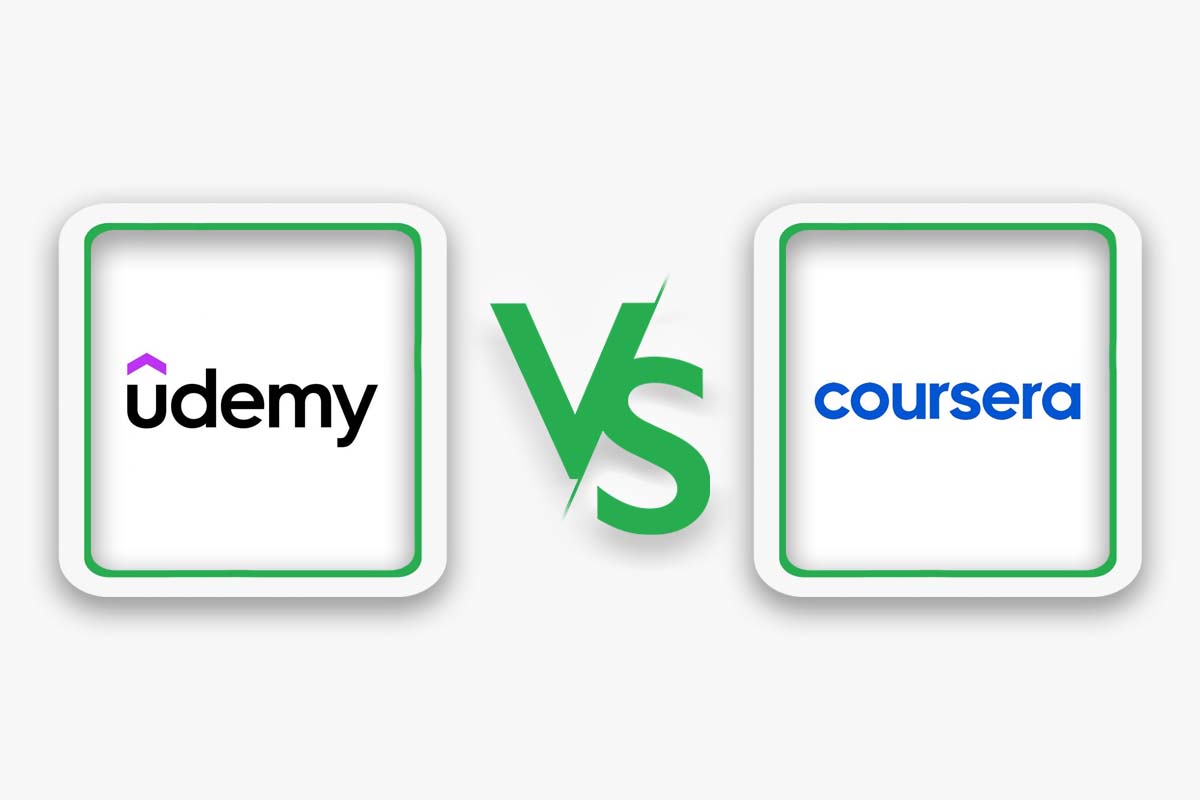We may earn revenue from the products available on this page and participate in affiliate programs. Learn More ›
Online courses have exploded in popularity in recent years, and for good reason—when compared to in-person classes, online learning is more accessible and affordable, the content is more diverse, and students can learn at their own pace. Whether students are continuing their formal education, acquiring a new skill or hobby in their free time, or brushing up on some technical skills for work, online learning platform options abound. Udemy and Coursera are just two of the most popular options among the best online course platforms out there. Faced with this choice, students may be wondering, “Which platform is the best fit for me?” Prospective students may also have questions, such as “Is Udemy legit,” and “Does a Coursera certificate have value?” Find the answers to these questions and more in this comparison of Udemy versus Coursera.
What is Udemy, and how does it work?

Udemy is an online learning platform with courses available in subjects ranging from IT to home improvement to the arts and more. The site operates on an open framework, which means that instructors from across the globe can upload their own videos and lessons. The result is a massive database of course material in a wide variety of languages, topics, and skill levels. Students can choose to purchase classes individually or sign up for a monthly subscription plan for access to over 8,000 classes. Check out our Udemy review to learn more.
What is Coursera, and how does it work?
Coursera partners with universities and companies to provide thousands of college courses to students in an online format. The site offers accredited classes taught by university professors, which means students can earn real college credit. Students may take individual courses or pursue a degree or certificate through one of Coursera’s guided programs. Classes are priced significantly lower than they would be at a college or university, and many courses are also available for free.
Udemy and Coursera Pros and Cons
| Pros | Cons | |
| Udemy |
|
|
| Coursera |
|
|
How We Compared Online Learning Platforms
- Subject categories: Both Udemy and Coursera offer thousands of class options, but ultimately a student will need to choose the option that offers the course material they need. The breadth of subject matter available is a vital factor in comparing online learning platforms
- Course structure: Can students be flexible with their learning, or are classes only offered at specific times? What kind of coursework or tests are required? Students will want to choose a platform that aligns with their schedule and learning style.
- Cost: In general, online classes are often offered at a lower cost than traditional in-person classes. However, students will still want to evaluate whether they are receiving a good value for the cost of the course or subscription plan.
- Course instruction: It would be difficult for instructors to have the same level of impact in an online classroom as they would in a physical one. However, some online platforms allow students to interact with their instructors and get feedback on their work, while other sites may not be able to offer this perk.
- Course accreditation: When students choose an accredited institution, they know that their course material has been evaluated by a third party and meets certain standards of quality.
- Certifications awarded: Students may want to seek courses that will earn them a certification if it is required by their employer or they are hoping to add this credential to their resume. They’ll need to verify that the course they choose not only teaches the information they need but will also award them a certificate after the course is completed.
- Site features and design: While site design may seem like a surface-level consideration, choosing an intuitive platform can eliminate confusion and frustration. Many online learning platforms have hundreds or even thousands of courses to choose from, so it’s worth considering how easy or difficult it is for students to filter for the course they need.
Udemy vs. Coursera: Subject Categories
Students starting out on Udemy or Coursera will notice that they have thousands of courses to choose from in various subjects. Udemy’s course catalog is organized under 13 umbrella categories: Development, Business, Finance & Accounting, IT & Software, Office Productivity, Personal Development, Design, Marketing, Lifestyle, Photography & Video, Health & Fitness, Music, and Teaching & Academics. Many Udemy classes are geared toward business and tech professionals looking to develop their skills. For example, software tutorials and coding boot camps are some of the top classes advertised on the site’s main landing page. Udemy students can expect to find these types of courses in higher volumes on the site than others. However, exploring some of the other categories, such as Health & Fitness and Lifestyle, reveals that Udemy offers plenty of lessons in the arts, home improvement, cooking, mindfulness, and much more. If a student can think of something that interests them, it’s likely that they can find at least one class on that topic on Udemy. Furthermore, instruction for each topic can typically be found for all skill levels, from those starting from scratch to seasoned professionals.
While there is some overlap in the type of subject matter found on Udemy and Coursera, the type of options Udemy has for hobbyists and casual learners aren’t available on Coursera. Coursera’s library is made up mostly of university classes, with some additional program offerings from large companies such as Google and Microsoft. Broad topics on Coursera include Data Science, Business, Computer Science, Information Technology, Language Learning, Health, Personal Development, Physical Science & Engineering, Social Sciences, Arts & Humanities, and Math & Logic. Because of Coursera’s partnership with colleges and universities, it is primarily geared toward career development, whether it be in the fields of tech, health care, science, academia, or others. While some introductory courses are offered, other classes may require students to take a prerequisite before enrolling.
Verdict: Coursera’s subjects mirror the offerings of a college or university, with classes covering topics in a range of categories from humanities to machine learning. Udemy offers classes over a wider range of subjects, from basic skills to complex topics, and the distribution of classes among these topics is more even than on Coursera.
Winner: Udemy

Udemy vs. Coursera: Course Structure
A major reason that students choose to pursue online educations instead of attending classes in person is time management. Eliminating the commute to and from a university campus can save hours each week for those who are also juggling jobs and family commitments. But some online course platforms are more flexible than others. While students taking individual classes on Coursera will have relative flexibility, those in degree programs will be required to adhere to a traditional schedule with live lectures held at regular intervals and homework and quizzes with strict deadlines. Other programs include Guided Projects for a more hands-on approach and Specializations for those looking to go in depth on one subject. Students may also need to sign up in advance to be enrolled for the semester rather than having the ability to start a course at their convenience. Students will only have access to the class resources and materials during the class term. Some classes may also not be available every term. This type of course structure can be inconvenient if lecture times overlap with work schedules. On the other hand, students who need external motivation may prefer the extra push that comes with having regularly scheduled lectures and coursework with deadlines.
Udemy courses are much more casual and flexible. Students can start learning as soon as they purchase the course and can take it at their own pace. Most classes are formatted as prerecorded video lectures, which students can pause and come back to at any time, with the option to access them on the go using the Udemy app. If any quizzes are provided, they are typically optional or are multiple choice and not graded by the instructor. Once a class has been purchased, the student retains lifetime access as long as they have their Udemy account. Students are free to revisit the material at any time or retake the class as often as they would like. Not only does Udemy’s more flexible structure make it possible for busy individuals to tailor their education to their needs, but it also makes it possible to work ahead and complete courses more quickly if desired. For some, this lack of structure may not be a pro. Those who prefer having traditional class times can schedule regular “learning reminders” through the site, add them to their calendar, and turn on push notifications to be prompted when it’s time to learn.
Verdict: Coursera classes are typically structured like a university course would be, with scheduled lectures and assignments for each week. Meanwhile, Udemy offers students the benefit of flexible learning: courses are self-paced, meaning students have as long as they want to work through the material and can do so at any rate that suits them.
Winner: Udemy
Udemy vs. Coursera: Cost
Studying online is relatively affordable compared with the cost to attend in-person classes or enroll in a university. While the low cost of an online learning platform can be financially viable for a higher volume of students, it’s worth investigating whether this decrease in cost goes hand in hand with a decrease in course quality. When it comes to Udemy and Coursera, prices can vary widely depending on the courses being taken and whether students sign up for subscription plans.
Udemy is an affordable option for most students—even those limited to taking only Udemy’s free courses would find that there is plenty of course material available for them. Other classes are available for individual purchase starting at around $9.99. There are no Udemy fees, and course prices are exactly as listed. Alternatively, students can sign up for a monthly Udemy subscription plan, which provides unlimited access to 8,000 of the courses on the site. Udemy also runs frequent promotions, so if a class is out of a student’s price range it may be worth monitoring the site to see if it goes on sale. Since individual class prices are set by the instructor, it is not always clear if a higher price point is indicative of higher-quality instruction. Students wondering, “Is Udemy good for the price?” can reference the ratings and reviews for a class to get a sense of whether past students felt they got their money’s worth. Udemy pricing is as follows:
- Personal Plan: $16.58 per month
- Individual Courses: Free, or $9.99 to $199.99 per class
At first glance, students may have sticker shock from the prices listed on Coursera. Individual courses can cost as much as $79 per month. Coursera Plus, which provides access to over 7,000 certificate programs, is available either as a monthly or annual subscription plan. Some Coursera reviews indicate that users were not aware that subscriptions auto renew, so students will want to make a note of when their plan ends. Degree program tuition is separate from the subscription options and may be charged per class or per credit hour. Coursera projects may also be priced individually. Students can apply for financial aid through the site if needed. While costs may be high compared to Coursera’s competitors, it’s worth noting that courses are guaranteed to be accredited, and they are taught by experts in their field. Those who are not ready to commit to a course can usually audit it for free, although they won’t receive a certificate and may not be able to access all of the course materials. Coursera cost options are listed below, but there are also thousands of free individual courses offered on the site.
Coursera
- Single Learning Program: $49 to $79 per month
- Coursera Plus Monthly: $59 per month
- Coursera Plus Annual: $399 per year
- Certificate and Degree programs: Varies
Verdict: Coursera offers several levels of access to learning materials. Some lessons, assignments, and discussion forums are available for free (though not all). Students can choose an unlimited membership at $59 per month (with all-access to materials), or they can take individual Coursera courses at a cost between $49 and $79. Comparatively, Udemy’s pricing structure makes access to learning more democratic: class prices start around $9.99, many classes are available for free, and Udemy has frequent sales to make the material even more affordable.
Winner: Udemy
Udemy vs. Coursera: Course Instruction
Since many classes offered on Udemy and Coursera are MOOCs, or “massive open online courses” with thousands of students, student-teacher interaction is practically impossible. Live and prerecorded virtual lectures don’t allow students to chime in with questions or stop the professor to ask for clarification. In many cases, the course instructor’s contact information is not published due to the volume of messages they would be likely to receive from so many students. However, some online course sites do include options for getting in touch with instructors. Coursera courses often include access to an open forum for discussions where the course instructor or fellow students can reply to posts. Some Udemy courses also allow students to message their instructors directly.
Another important point is instructor qualification. Coursera has the advantage of offering accredited courses, meaning that its instructors are affiliated with a university. Students know that when they enroll in a Coursera class, the professor is at least as qualified as any they would encounter on a college campus, with many being well established and recognized in their fields. By contrast, Udemy’s open framework allows anyone to upload a course at any time. This is both an advantage and a disadvantage—for one, it means that course materials are available in thousands of topics and hundreds of languages and allows for the inclusion of information and perspectives from all over the world. On the other hand, it is impossible to vet this volume of content thoroughly. So for those who are wondering, “Is Udemy accredited?” the answer is unfortunately no. Udemy has quality-assurance measures in place, but content quality can still vary significantly. So while some Udemy instructors are just as qualified as the average professor on Coursera if not more so, others may not be credentialed at all. Students can rely on course reviews on Udemy to see if an individual class is worth taking. Both Udemy and Coursera also feature instructor bios with each course for students to refer to.
Verdict: Coursera courses are created and taught by university faculty, which is important for the higher-level material taught on the platform, whereas Udemy instructors don’t require any credentials. However, Coursera doesn’t allow students to reach out to instructors, while Udemy students are able to send messages to their instructors.
Winner: Tie

Udemy vs. Coursera: Course Accreditation
When an institution is accredited, this means that its course curriculums have been thoroughly vetted by a third party. Accredited courses must reach a specific level of quality and are regularly re-evaluated to ensure that they continue to meet these standards. Depending on a student’s goals, a lack of accreditation may or may not be a deal breaker when choosing an online course platform. For example, someone who is taking a course to brush up on their public speaking will likely be able to glean valuable insights from an unaccredited program. Similarly, those who are interested in learning a hobby or are simply curious about a new subject can take an unaccredited course. On the other hand, someone studying to become a real estate agent will need to be sure that the instruction they are receiving is current so that they can pass their exams.
If a student choosing between Udemy and Coursera is only interested in accredited courses, they will want to go with Coursera. One reason is quality assurance—because these are legitimate university courses, students can expect the information to be accurate and up to date. Courses being accredited also means that students can receive college credit or certifications that get them closer to their career goals. Finally, job seekers may choose to take Coursera classes from prestigious universities such as Yale or Johns Hopkins in order to make them stand out from other candidates. Only Coursera offers certificates and degrees from big-name schools like these.
Udemy classes are not subject to any kind of accreditation process. Students will also want to keep in mind that Udemy courses undergo very little external review before being published on the site. Students will need to rely on the reputation of the instructor and reviews from past students to vet the class rather than an official third party. Udemy instructors are also not required to update their material. For evergreen topics like mindfulness, gardening, or music, it may not matter if the course has not been updated since being published. But for something like a software tutorial, a course that was published several years ago and has not undergone an update is likely to be outdated. Fortunately, a “last updated” date appears in the course description of every class so students can get an idea of how recent the material is before they purchase it.
Verdict: Neither the Udemy platform nor its courses are accredited, meaning that there is no third-party verification of the quality of the instruction or information. Since Coursera courses are from accredited universities, there is a certain level of quality control to the material being taught—and students can rest assured that they are getting a valuable online education for their money.
Winner: Coursera
Udemy vs. Coursera: Certifications Awarded
Learning for learning’s sake is undoubtedly valuable. Hobbyists and casual students won’t typically need more than a certificate of completion from their course platform to validate their hard work. But if a student is pursuing a degree or certificate, they will need to earn credit for the classes they take. In this case, they will want to verify that they will receive credit or a certificate before signing up.
Students who are in the process of earning a degree or a certificate will want to go with Coursera. Coursera offers options for students who are pursuing a bachelor’s degree, master’s degree, or university certificate. Students can enroll in degree programs from a wide variety of universities and receive real college credit upon completion. Certificates can either provide students with the required qualifications to enter a field of employment or increase their chances of being hired due to increased expertise. Alternatively, course certificates are available for students who audit the class, or complete it without officially enrolling. These will not count as credit but signify that a student has taken the course. It’s important for students to understand their educational needs and ensure that the program they choose will get them closer to their goals.
Unfortunately, a Udemy certificate isn’t worth as much. At the end of every Udemy course students will receive a certificate of completion, but even the best Udemy courses cannot be counted toward any official certificates or degrees. They also are not likely to hold much significance to future employers. However, that does not mean that there are no benefits of a Udemy certificate. For one, adding a Udemy certificate to a LinkedIn profile can show initiative and commitment to continuing education. Udemy can also prove valuable in giving students tools and information for advancement. For example, a student may not necessarily include their certificate of completion of an Udemy Adobe Illustrator course on their resume, but they can use what they learned to complete projects to add to their portfolio.
Verdict: Udemy courses provide students with a certificate of completion only. Coursera has more variety in the certificates provided upon course completion, and students can go as far as earning postgraduate degrees through the platform.
Winner: Coursera
Udemy vs. Coursera: Site Features and Usability
Site usability may not be the first consideration that comes to mind when students begin choosing an online course platform. But unintuitive website design can quickly become a huge frustration, especially for those who anticipate signing up for a subscription and becoming long-term users. Browsing courses, figuring out pricing, and understanding exactly what to expect from the platform are all much more difficult when not supported by the site features.
Udemy’s site is fairly intuitive and browsable. Despite having thousands of courses on hundreds of topics, students can find what they are looking for with relative ease. When it comes time to choose a class, students can explore a list of course categories or type in their chosen topic in the search bar. From there, they can filter results by ratings, duration, topic, subcategory, level, language, price, features, and subtitles. Course prices are clearly listed alongside each class, and students can save classes they are interested in by clicking on the heart next to “add to cart.” Once courses have been purchased, they are easy to locate in the top-right corner of the site under “My Learning.”
Coursera students may have more criteria to consider, including whether a class is needed for their degree, if there are any prerequisites, when the course is being offered, and what kind of credit they will receive. With the many courses, universities, programs, and subscriptions to choose from, navigating the site can feel like information overload. Students can start by choosing the field of study they are interested in or the type of degree or certificate they need. They can also browse all course offerings or type in what they need in the search bar. There are some filter options to sift through these results, but they can be confusing for those who are new to the site or are not sure what they are looking for. Clicking on a category like Business or Arts & Humanities under “Subjects” returns a mix of courses, degree programs, certificates, MasterTracks, and specializations without indicating what each of these means. Over time it may become easier for students to navigate the site as they become more familiar with Coursera’s offerings. However, confusion at the beginning of a student’s journey could mean starting off on the wrong track or not being able to locate the program they need.
Verdict: Udemy has a manageable, intuitive, and clear user interface, whereas Coursera’s has the potential to confuse newer users from the start, with a difficult-to-navigate selection of menus. Udemy also has more search filters and sorting options, which makes finding the right class much easier.
Winner: Udemy
Verdict: Students looking for professional certifications or postgraduate degrees to further their careers or move into a new field can benefit from choosing Coursera, which provides access to courses from universities around the world. Students simply looking to improve a skill or take up a new hobby will enjoy Udemy’s affordable pricing and more than 200,000 classes to choose from.
Both Udemy and Coursera are valuable resources for students who are interested in online education. However, when it comes down to what each platform offers, the sites serve slightly different purposes. Coursera is ideal for those interested in accredited, college-level instruction. Coursera can meaningfully help students advance their careers or pivot to new ones by helping them acquire the appropriate credentials. Casual learners may find that the relatively higher prices on Coursera do not match their commitment level if they are not pursuing a degree. For them, Udemy is an attractive alternative. Students can take any Udemy course on demand without being limited by terms or due dates. Udemy’s massive library of courses means that just about anyone can find a class on the topic they are looking for, probably at a reasonable price (but if not, they can try one of the best Udemy alternatives). Because of these differences, it would be difficult to definitively say whether Udemy or Coursera is the superior platform—the choice depends on what students are hoping to achieve. Either way, Udemy and Coursera both offer thousands of free courses, meaning students can try either platform and decide for themselves with no risk.









